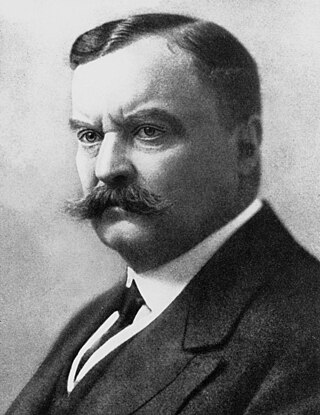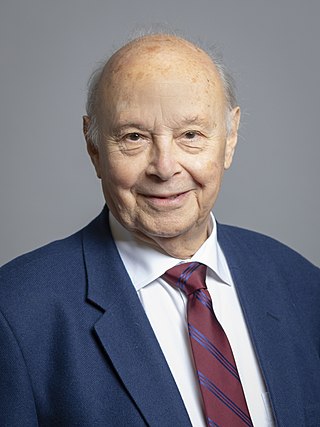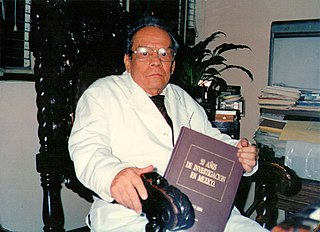Brucellosis is a zoonosis caused by ingestion of unpasteurized milk from infected animals, or close contact with their secretions. It is also known as undulant fever, Malta fever, and Mediterranean fever.

Major-General Sir David Bruce was a Scottish pathologist and microbiologist who made some of the key contributions in tropical medicine. In 1887, he discovered a bacterium, now called Brucella, that caused what was known as Malta fever. In 1894, he discovered a protozoan parasite, named Trypanosoma brucei, as the causative pathogen of nagana.

Brucella is a genus of Gram-negative bacteria, named after David Bruce (1855–1931). They are small, non-encapsulated, non-motile, facultatively intracellular coccobacilli.

Brucella melitensis is a Gram-negative coccobacillus bacterium from the Brucellaceae family. The bacterium causes ovine brucellosis, along with Brucella ovis. It affects primarily sheep and goats, but cases have also been observed in cattle, yaks, water buffalo, Bactrian and dromedary camels, alpacas, dogs, horses and pigs. Humans can become infected if they have contact with an infected animal or its byproducts. Animals acquire B. melitensis by venereal transmission and contact with the placenta, fetus, fetal fluids, and vaginal discharges from infected animals. The organism is found in blood, urine, milk, and semen. It is zoonotic, unlike B. ovis, causing Malta fever or localized brucellosis in humans.

Leslie Arnold Turnberg, Baron Turnberg,, is a British medical professional and an author of many publications and books related to the medical and health services fields. His experience extends to areas of research in these fields, and maintaining a clinical practice. He has published four books and some 150 articles on medical and scientific research. He has written two books on the history of Israel: Beyond the Balfour Declaration; the 100 Year Quest for Israeli-Palestinian Peace was published in 2017, and Mandate: Britain's Palestinian Burden, 1919–1939 was published in 2021.

Brigadier Sir Neil Hamilton Fairley, was an Australian physician, medical scientist, and army officer who was instrumental in saving thousands of Allied lives from malaria and other diseases.

Air Vice Marshal Sir Charles Putnam Symonds was an English neurologist and a senior medical officer in the Royal Air Force.
Warburg's tincture was a pharmaceutical drug, now obsolete. It was invented in 1834 by Dr. Carl Warburg.
Edward McCombie McGirr (1916-2003) was Muirhead professor of medicine at Glasgow Royal Infirmary, a former President of the Royal College of Physicians and Surgeons of Glasgow and Dean of Faculties at the University of Glasgow.

Air Marshal Sir Harold Edward Whittingham was a British physician notable for a distinguished medical career in the Royal Air Force and contributions to Aviation medicine. After graduating from the University of Glasgow, he was the first pathologist and Assistant Director of Research at the Beatson Institute for Cancer Research in Glasgow.

Sir Edward George Sayers was a New Zealand medical doctor, parasitologist, Methodist missionary, military medical administrator, consultant physician and, from 1958 to 1968, Dean of the University of Otago, School of Medicine. Having trained as a doctor, from 1927 to 1934 he worked at the Methodist mission in the Solomon Islands where he carried out fieldwork in the treatment of malaria. The significance of this work became apparent when Sayers used his knowledge to reduce deaths of American, Australia and New Zealand military forces during the invasion of Pacific Islands during World War II. He served as a doctor with the 2nd Division 2 NZEF during 1941–42 in Greece and North Africa. In 1942 he was transferred to the Pacific to serve with the 3rd Division, 2 NZEF IP.
Ray Fletcher Farquharson was a Canadian medical doctor, university professor, and medical researcher. Born in Claude, Ontario, he attended and taught at the University of Toronto for most of his life, and was trained and employed at Toronto General Hospital. With co-researcher Arthur Squires, Farquharson was responsible for the discovery of the Farquharson phenomenon, an important principle of endocrinology, which is that administering external hormones suppresses the natural production of that hormone.
The Manson Medal, named in honour of Sir Patrick Manson, is the highest accolade the Royal Society of Tropical Medicine and Hygiene awards. Started in 1923, it is awarded triennially to an individual whose contribution to tropical medicine or hygiene is deemed worthy by the council.

John Oldroyd Forfar, MC, FRSE was a Scottish paediatrician and academic. He served in the Royal Army Medical Corps during the Second World War and later became a leading civilian paediatrician. He was Professor of Child Life and Health at the University of Edinburgh from 1964 to 1982. He was President of the British Paediatric Association from 1985 to 1988, and was instrumental in the founding of the Royal College of Paediatrics and Child Health.
Air Vice-Marshal John Nigel Carlyle Cooke, was a British doctor and senior Royal Air force officer. He served as Dean of Air Force Medicine from 1979 to 1983, and Senior Consultant RAF from 1983 to 1985. He was also a medical advisor to the European Space Agency, the Royal Air Force of Oman and the Civil Aviation Authority.
Lieutenant-General Sir James Parlane Baird, was a British Army officer and doctor. He served as Director General Army Medical Services from 1973 to 1977.

Alberto P. León (1909-2001) was the Secretary of Health of Mexico beginning in 1939. He is the 1991 holder of the Mexican National Prize on Medicine and Health.
Kenneth Gordon Lowe (1917–2010) was a Scottish physician who did pioneering research as a nephrologist and as a cardiologist.

Arnaldo Cantani, also known as Arnoldo Cantani was an Italian physician and writer best known for his research on diabetes.
Wesley William Spink was an American physician, medical school professor, college coach, and medical researcher. He was "an internationally recognized authority on infectious diseases and is credited with controlling the spread of brucellosis ".